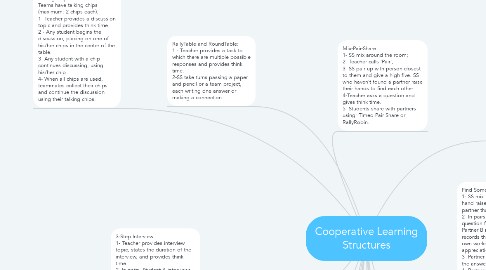Cooperative Learning Structures
by Félix McMurray

1. Mix-Pair-Share: 1- SS mix around the room; 2- Teacher calls 'Pair'; 3- SS pair up with person closest to them and give a high five. SS who haven't found a partner raise their hands to find each other. 4-Teacher asks a question and gives think time. 5- Students share with partners using: Timed Pair Share or RallyRobin.
2. Activity of my choice (Chapter 6): Job Thoughts 1-Teacher names a topic, sets a time limit, and provides think time. 2- Students write and announce as many ideas as they can in the allotted time, one idea per slip of paper. 3- Each slip of paper is placed in the centre of the table; SS attempt to 'cover the table.'
3. RallyTable and RoundTable: 1 - Teacher provides a task to which there are multiple possible responses and provides think time. 2-SS take turns passing a paper and pencil or a team project, each writing one answer or making a connection.
4. Talking Chips: Teams have talking chips (maximum: 2 chips each). 1- Teacher provides a discussion topic and provides think time. 2 - Any student begins the discussion, placing on one of his/her chips in the center of the table. 3- Any student with a chip continues discussing, using his/her chip. 4- When all chips are used, teammates collect their chips and continue the discussion using their talking chips.
5. 3-Step Interview: 1- Teacher provides interview topic, states the duration of the interview, and provides think time. 2- In pairs, Student A interviews Student B. 3 - Pair switch roles: S-B interviews S-A. 4- Use RoundRobin: Pairs pair up to form groups of 4. Each student, in turn, shares with the team what s/he learned in the interview.
6. Timed Pair Share: 1- Teacher announces a topic, states how long SS will share, and provides think time. 2- In pairs, Partner A shares; Partner B listens. 3- Partner B responds with a positive gambit. 4- Partners switch roles.
7. Heads Together: 1- SS number off. 2-Teacher poses a problem and gives think time. 3- SS privately writ their answers. 4- SS stand up and put their heads together," showing answers, discussing, and teaching each other. 5- SS sit down when everyone knows the answer or has something to share. 6- Teacher calls a number and the student with that number answers. 7- Classmates applaud SS who responded.
8. Think-Pair-Share: 1- Have SS write a response to a prompt/question individually. 2- Tell SS to pair up and share their responses. 3- Reconvene the class and ask pairs to report back on their conversations.
9. Crossword Puzzle Jigsaw: 1- Give each student a card with a cue. 2 - One student has the jigsaw. 3 - Each student takes a turn (in teams of 4) and reads what s/he has on the card. 5- SS need to guess what the word is.
10. Within-Team Jigsaw: 1- Give a different task to each student in the team. 2-Students use RoundRobin to teach the others what they have learned.
11. Classic Jigsaw: 1-SS start in their home groups. 2- Each student has a different text (sub-topic), but all texts are about the same topic. 3- Students move into expert groups (groups about the same sub-topic). 4- Expert groups break apart and students return to home groups. Now, each of the students is an expert in one area of the topic and can share his knowledge with rest of the group.
12. RallyRobin and RoundRobin: 1- Teacher poses a problem to which which there are multiple possible responses or solutions, and provides think time. 2- SS take turns stating responses or solutions.
13. Find Someone Who: 1- SS mix in the class, keeping a hand raised until they find a partner that is not a teammate. 2- In pairs, Partner A asks a question from the worksheet; Partner B responds. Partner A records the answer on his/her own worksheet and expresses appreciation. 3- Partner B checks and initials the answer. 4- Partner B repeats Step 2. 5-Partner A checks and initials the answer. 6-Partner shake hands, part, and raise a hand as they search for a new partner. 7- SS repeat Steps 1-6 until their worksheets are complete. 8-When their worksheets are complete, SS sit down; seated students may be approached by others as a resource. 9- In teams, SS compare answers; if there is disagreement or uncertainty, they raise 4 hands to ask a team question.
14. Inside-Outside Circle: 1- SS form pairs. One student from each pair moves to form one large circle in the class facing outward. 2- Remaining SS find and face their partners (class now stands in 2 concentric circles). 3-Inside circle SS ask a question from their question card; outside circle SS answer. Inside circle SS praise or coach. 4- Partners switch role: Outside circle SS ask, listen, then praise or coach. 5- Partners trade question cards. 6- Inside circle SS rotate clockwise to a new partner.
15. Team Pair Solo: 1- Students are grouped into teams to complete a task. 2-Students break into pairs. 3- Students solve the task individually.
16. Think-Square-Share: 1- Have SS write a response to a prompt/question individually; 2- Tell SS to get in a group of four. 3- Reconvene the class and ask groups to report back on their conversations.
17. Pairs Jigsaw: 1- Divide the class into 2 parts. 2- Give material to half the class, and the other half is given other material to master. 3- When they have finished, a person with each topic finds a partner with the other topic, and they take turns teaching each other what they have learned.


